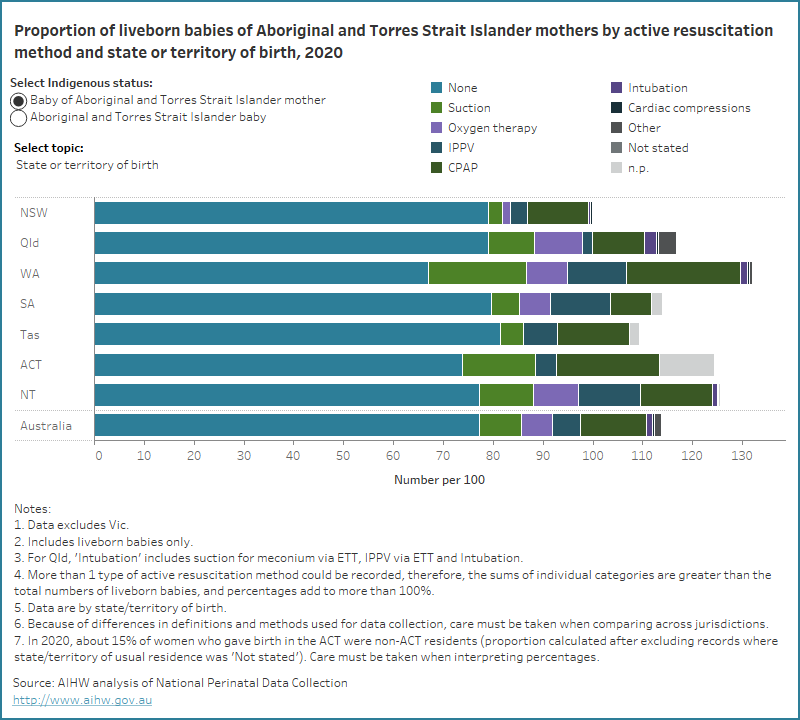 Active resuscitation method
Active resuscitation method
Resuscitation is undertaken to establish independent breathing and heartbeat or to treat depressed respiratory effect and to correct metabolic disturbances. Active resuscitation methods range from less advanced methods like suction or oxygen therapy to more advanced methods, such as external cardiac massage and ventilation. Data are for liveborn babies only. More than one method of resuscitation can be recorded.
Some babies are more likely to require resuscitation such as babies of mothers with pre-existing or pregnancy-induced health conditions, babies born as part of a multiple birth, babies who are born pre- or post-term and babies born by instrumental vaginal or caesarean section birth (Victorian Newborn Resuscitation Project 2021).
In 2020, most babies of Aboriginal and Torres Strait Islander mothers did not require active resuscitation (77 per 100 liveborn babies of Aboriginal and Torres Strait Islander mothers), compared with 80 per 100 liveborn babies of non-Indigenous mothers.
Of those babies of Aboriginal and Torres Strait Islander mothers who did require resuscitation, continuous positive airway pressure was the most common resuscitation method (13 per 100), followed by suction (8.5 per 100) and oxygen therapy (6.2 per 100) (compared with 9.8 per 100 liveborn babies of non-Indigenous mothers requiring continuous positive airway pressure, 7.1 per 100 requiring suction and 4.6 per 100 requiring oxygen therapy).
The data visualisation below presents data on active resuscitation method for liveborn babies of Aboriginal and Torres Strait Islander mothers and Aboriginal and Torres Strait Islander babies, by selected maternal and baby characteristics for 2020.
Figure 1: Proportion of liveborn babies of Aboriginal and Torres Strait Islander mothers Aboriginal and Torres Strait Islander babies by active resuscitation method and selected topic for 2020
Bar chart for active resuscitation method by selected topics. 77 per 100 babies of Aboriginal and Torres Strait Islander did not require resuscitation.

Amongst babies of Aboriginal and Torres Strait Islander mothers in 2020, those less likely to require resuscitation were those who:
- had a healthy birthweight (81 per 100 did not require resuscitation, compared with 70 per 100 with high birthweight and 54 per 100 with low birthweight)
- were born at term (82 per 100 did not require resuscitation, compared with 48 per 100 born pre-term)
- were a singleton (78 per 100 did not require resuscitation, compared with 44 per 100 babies born as part of a multiple birth)
- were born to mothers aged 20-24 years (79 per 100 did not require resuscitation, compared with 75 per 100 for babies of mothers aged under 20 years).
References
Victorian Newborn Resuscitation Project (2021) Risk factors, neoResus website, accessed 18 October 2022


